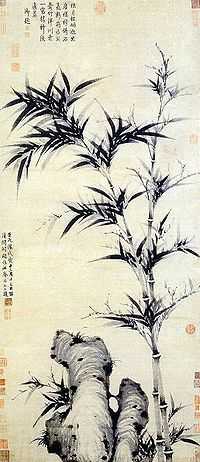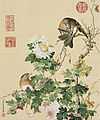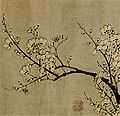Four Gentlemen
| Four Gentlemen | |||||||||||||||||||||||
| Chinese name | |||||||||||||||||||||||
|---|---|---|---|---|---|---|---|---|---|---|---|---|---|---|---|---|---|---|---|---|---|---|---|
| Chinese | 四君子 | ||||||||||||||||||||||
| |||||||||||||||||||||||
| Vietnamese name | |||||||||||||||||||||||
| Vietnamese | Tứ Quân Tử | ||||||||||||||||||||||
| Hán-Nôm | 四君子 | ||||||||||||||||||||||
| Korean name | |||||||||||||||||||||||
| Hangul | 사군자 | ||||||||||||||||||||||
| Hanja | 四君子 | ||||||||||||||||||||||
| |||||||||||||||||||||||
| Japanese name | |||||||||||||||||||||||
| Kanji | 四君子 | ||||||||||||||||||||||
| Hiragana | しくんし | ||||||||||||||||||||||
| |||||||||||||||||||||||
The Four Gentlemen, also called the Four Noble Ones, in Chinese art refers to four plants: the orchid, the bamboo, the chrysanthemum, and the plum blossom.[1][2] The term compares the four plants to Confucianist junzi, or "gentlemen". They are most typically depicted in traditional ink and wash painting and they belong to the category of bird-and-flower painting in Chinese art.
The Four Gentlemen have been used in Chinese painting since the time of the Chinese Song Dynasty (960–1279) because of their refined beauty, and were later adopted elsewhere in East Asia by artists in Korea, Japan, and Vietnam. As they represent the four different seasons (the orchid for spring, the bamboo for summer, the chrysanthemum for autumn, and the plum blossom for winter), the four are used to depict the unfolding of the seasons through the year.
Gallery
-

Orchids and Bamboo by Zheng Xie, c. 1740
-

Bamboo at Qingbige Pavillion by Ke Jiusi, c. 1338
-

Chrysanthemums from the Xian'e Changchun Album by Giuseppe Castiglione (1688-1766)
-

Plum Blossoms by Sun Long and Chen Lu, early Ming Dynasty (1368–1644)
See also
References
External links
- Paintings of the Four Gentlemen at China Online Museum